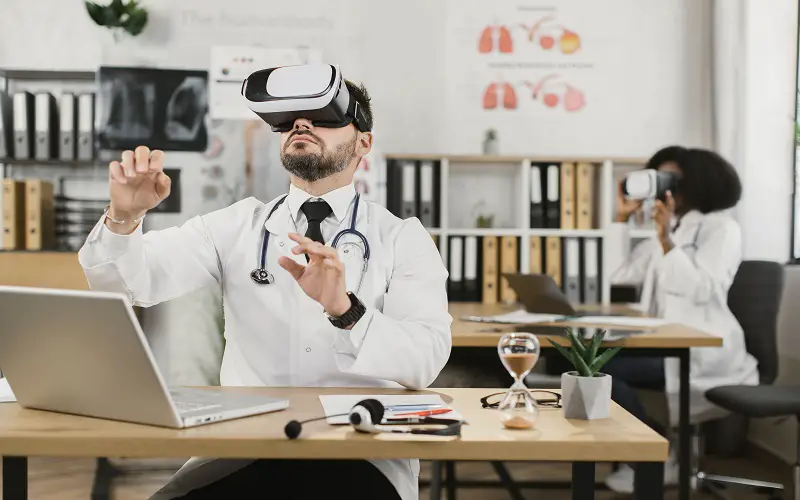Healthcare software development has revolutionized the healthcare industry by introducing innovative ways to deliver and receive healthcare services for both patients and healthcare providers. Electronic health records (EHRs) and wearable devices are just a few examples of the latest healthcare software innovations that are improving patient outcomes, increasing efficiency, and reducing healthcare costs. In this article, we will delve into some of the latest healthcare software development innovations that are transforming the healthcare industry.
Electronic Health Records (EHRs)
Electronic health records (EHRs) are digital versions of patient medical records that are stored electronically. EHRs provide healthcare providers with a comprehensive view of a patient’s medical history, including lab results, medication lists, and other important medical information. EHRs can be accessed from any location with an internet connection, which makes it easy for healthcare providers to collaborate and share patient information.
The advantages of EHRs are numerous. EHRs reduce the risk of medical errors by providing healthcare providers with up-to-date and accurate patient information. EHRs also improve patient care by providing healthcare providers with access to real-time patient data, allowing for quicker and more accurate diagnoses. There are several types of EHRs available, including cloud-based EHRs and standalone EHRs.
Telemedicine
Telemedicine is the use of telecommunications technology to provide healthcare services to patients who are not physically present in a healthcare setting. Telemedicine services can include remote consultations, virtual visits, and remote monitoring of patients. Telemedicine application platform is especially beneficial for patients who live in remote areas, have mobility issues, or have difficulty accessing healthcare services.
The advantages of telemedicine are many. Telemedicine reduces the need for patients to travel to healthcare facilities, which can save time and money. Telemedicine also allows healthcare providers to provide care to patients who might not otherwise receive it. There are several types of telemedicine available, including real-time video consultations, remote monitoring, and store-and-forward telemedicine.
Artificial Intelligence (AI) in Healthcare
Artificial intelligence (AI) is being used to analyze large amounts of healthcare data to identify patterns, predict outcomes, and improve patient care. AI can also be used to develop personalized treatment plans for individual patients. Some examples of AI in healthcare include chatbots that can answer patient questions, predictive analytics that can identify patients at risk of developing certain conditions, and image analysis software that can help healthcare providers diagnose diseases.
An example of a highly efficient software in this field is Foothold Technology. This care coordination software enables networks to perform essential functions, including enrollment, case management, screening, referrals, eligibility checks and handling bills. It assists in managing and moving data between internal and external stakeholders.
The advantages of AI in healthcare are significant. AI can help healthcare providers make more informed decisions about patient care, improve patient outcomes, and reduce healthcare costs. AI can also help to streamline administrative tasks, allowing healthcare providers to spend more time on patient care.
Wearable Devices
Wearable devices are electronic devices that can be worn on the body, such as fitness trackers, smartwatches, and medical monitoring devices. Wearable devices can be used to monitor a wide range of health metrics, including heart rate, sleep quality, and blood pressure. Wearable devices can also be used to monitor patients with chronic conditions, such as diabetes or heart disease.
The advantages of wearable devices are numerous. Wearable devices can provide patients with real-time feedback on their health, which can help them make lifestyle changes to improve their health outcomes. Wearable devices can also help healthcare providers to monitor patients remotely, reducing the need for frequent office visits.
Big Data Analytics
Big data analytics is the process of analyzing large amounts of data to identify patterns, trends, and insights. In healthcare, big data analytics can be used to identify patients at risk of developing certain conditions, predict disease outbreaks, and develop personalized treatment plans. Big data analytics can also be used to identify inefficiencies in healthcare delivery and reduce healthcare costs.
The advantages of big data analytics in healthcare are significant. Big data analytics can help healthcare providers to make more informed decisions about patient care, improve patient outcomes, and reduce healthcare costs. Big data analytics can also be used to improve population health by identifying trends and patterns in large populations.
Internet of Things (IoT)
The Internet of Things (IoT) refers to the network of interconnected devices that can communicate with each other over the internet. In healthcare, IoT devices can be used to monitor patients remotely, track inventory and equipment, and improve the patient experience. Some examples of IoT devices in healthcare include smart beds that can adjust to the patient’s position, sensors that can monitor medication adherence, and smart thermometers that can monitor a patient’s temperature.
The advantages of IoT in healthcare are numerous. IoT devices can improve patient outcomes by providing real-time patient data to healthcare providers. IoT devices can also reduce healthcare costs by streamlining administrative tasks and improving the efficiency of healthcare delivery.
Conclusion
The latest software innovations in healthcare are changing the way that healthcare is delivered and received. From EHRs to IoT devices, these innovations are improving patient outcomes, increasing efficiency, and reducing healthcare costs. As the healthcare industry continues to evolve, it is likely that we will see even more software innovations that will further revolutionize healthcare.




